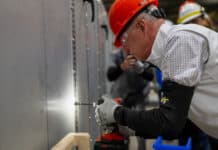By Michael Daly, P.E.
From the December 2022 Issue
As professionals in facilities services, being well versed in commercial HVAC preventative maintenance (PM) is key to ensuring systems are operating at peak efficiency. But what about the inevitable—like efficiency degradation?
Clearly neglected maintenance, soiled filters, dirty condenser and evaporator coils, worn contactors, out of spec capacitors, leaking ducts, excessive scale buildup in chilled water systems, etc., will all lead to efficiency loss. PM schedules address these items based upon what is determined as an appropriate frequency, affected by resource constraints in manpower and dollars.

But what are the best practices? Do they vary by building and equipment type or operational use? HVAC systems lose efficiency over time, but by following these strategies, FMs can help improve their facility performance gains and energy goals.
Not All PM Schedules Are The Same
As one example, a facility lead is responsible for a corporate headquarters complex with older buildings and roughly 70 RTUs that looked well maintained. As part of his routine PM, his general practice is to replace contactors every five years, regardless of what they looked like. This approach works well for this individual and the buildings’ owner, fully understanding that some good contactors are being tossed while perhaps some should be replaced sooner. Time and budget constraints impact an FMs selection of an appropriate PM schedule. They make judgement decisions by acknowledging that performance starts degrading as soon as dust starts collecting after we clean the coils and replace filters.
Building Management Systems, and more advanced HVAC equipment with self-monitoring, enable us to set parameters of when maintenance is warranted. However, it still comes down to a judgement call (utilizing equipment specifications and other information) to determine where to set each respective parameter. With good data that gives some measure of equipment performance, we can tune our PM schedules to optimize energy use and head off equipment failures.
Efficiency Loses From Aging Equipment
Regardless of the thoroughness and frequency of PM, the HVAC equipment loses performance efficiency as it ages. How well equipment ages is impacted by PM, along with run time, loading, local environmental conditions, and varies by manufacturer and equipment model.
Components of the system:
- Refrigerant: Should or could last the life of the equipment pending that it doesn’t get contaminated.
- Mechanical Moving Parts: These are most prone to wear, greatly impacted by the condition of the lubricant.
- Refrigerant Loop/Coils: May be subject to pin holes from corrosion or wear and suffer efficiency loss as circulating refrigerant oil coats the inside of coil surfaces.
- Electrical Components: Get stressed from loading and environmental conditions.
With chillers and more sophisticated packaged units, we get performance data to help us recognize if or when performance starts degrading. Conducting chiller water and oil analyses enables us timely management of chiller systems, whether identifying chilled water scale build up, mechanical wear, or degraded oil. Yet, hermetically sealed compressors don’t afford the same opportunity to track oil properties, so we must rely on electrical consumption and supply/return temperature data to monitor equipment health.
All systems lose efficiency over time. When chillers’ performance significantly drops or there is continued down time, these systems can have the oil replaced, tubes punched, or complete rebuilds. Hermetically sealed systems as found in most DX equipment will ultimately just be replaced at the component level or entire systems.





















![[VIDEO] Collect Asset Data at the Speed of Walking a Building](https://facilityexecutive.com/wp-content/uploads/2024/02/maxresdefault-324x160.jpg)